Research Highlights
Please find below an overview of the current research projects at D-ITET. This list is regularly updated.
Also have a look at our research videos and our research key topics.
Exploring new horizons for kite power
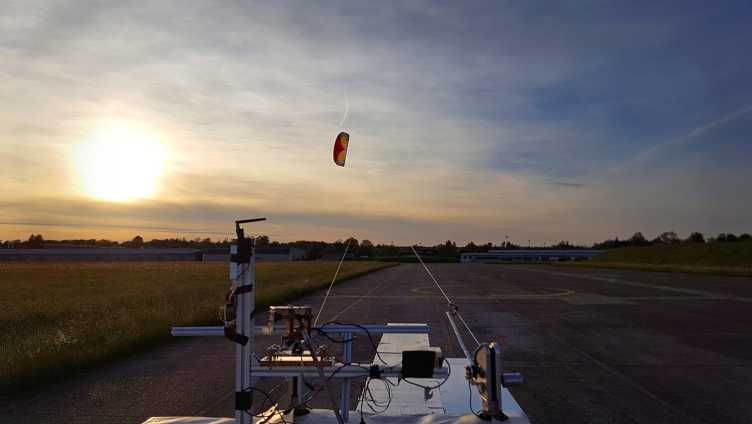
The world is facing a growing demand on renewable energy. Airborne Wind Energy generators are a promising tool for providing more of such renewable energy at low cost. Automatic control is crucial for making Airborne Wind Energy systems work efficiently and reliably. Airborne Wind Energy systems harvest wind energy by exploiting the aerodynamic forces generated by autonomous tethered wings, flying fast in crosswind conditions. This technology is able to reach higher altitudes than conventional wind turbines, where the wind is generally stronger and more consistent, while at the same time reducing the construction and installation costs of the generator. More information
What came first, localisation or autonomy?
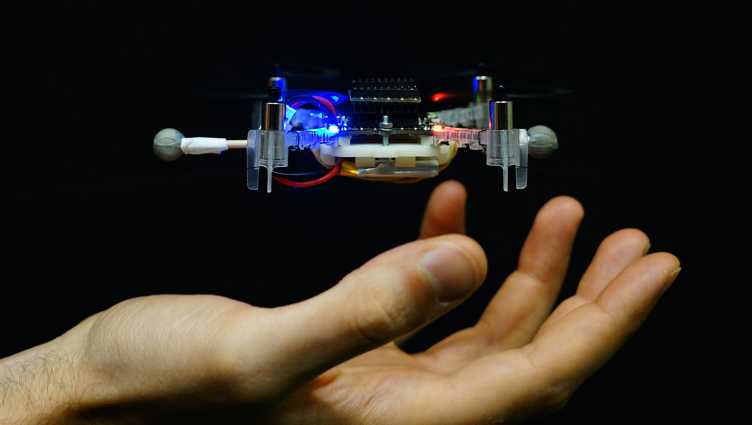
The answer, of course, is both and neither. A fleet of nano-quadcopters, the Crazyflies, are demonstrating that autonomous decision-making methods are applicable beyond the walls of a lab. Crazyflies carry the latest in sensing and computing hardware, and represent autonomous flying robots that are both inherently challenging to control and awesome to watch. The researchers at the Automatic Control Laboratory are aiming to have a swarm of Crazyflies making decisions on their own, all by communicating with the others to cooperatively tackle a task such as flying in formation. To ensure their autonomy, the researchers also work on algorithms to improve their abilities of precise localisation, using Ultra-Wide-Band technology. More information
Enabling multiple robots to work together
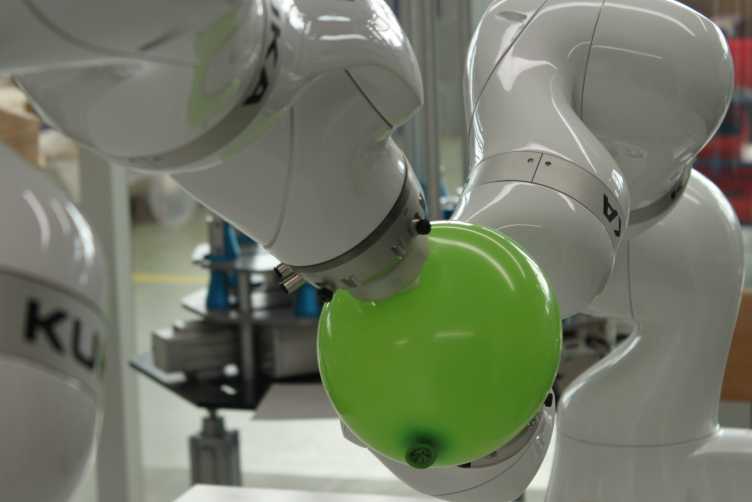
Robots increasingly enter industry as well as our everyday lives. There are many complex tasks, which cannot be tackled by one robot alone, but only by a team of robots, e.g. on a construction site where heavy or large objects need to be carried. Here the robots really need to work, interact and possibly also communicate with each other. Both the position of the object as well as the interaction forces need to be controlled to make sure that the object is neither dropped nor squeezed and damaged. We therefore work on algorithms, which enable multiple robots to work together. More information
Hacking CPUs (and how to stop it)

To make the most of out of the ever-increasing number of transistors, CPUs do crazy things to increase the performance of software that runs on top of them. For example, they always try to guess what the software is going to do next and try to do it ahead of time. So there are all kinds of guessing, and the CPUs that guess more and guess better happen to become faster at executing software. Unfortunately if done carelessly, this guesswork can lead to security problems. In our research, we try to make CPUs guess incorrectly under different conditions and investigate whether this can lead to data breaches. It is magical when one observes CPUs leaking sensitive information in ways that should not be possible! After finding problems, we usually put on our defender hats and try to help CPU and software designers come up with remedies against these serious security vulnerabilities.
Computer vision for autonomous cars
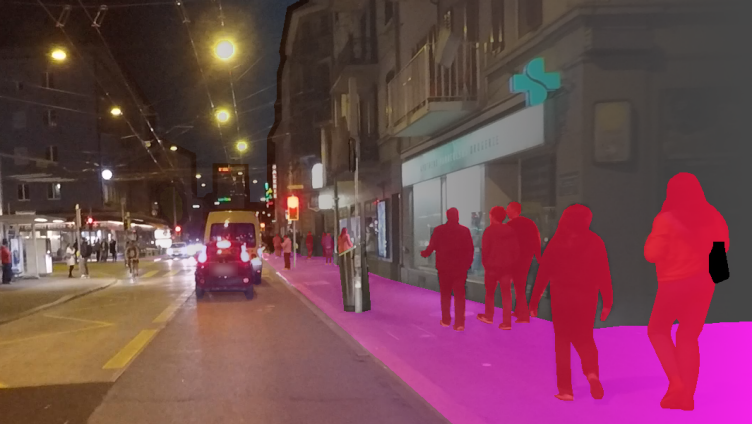
Developments in autonomous cars have been accelerated tremendously in recent years. However, the challenge of automatically perceiving the environment of autonomous cars accurately and reliably in order to drive them safely still persists and prevents large-scale deployment of this transforming technology. Computer Vision Laboratory has a long-standing research collaboration with Toyota, one of the leading players in autonomous cars, via the research project TRACE (Toyota Research on Autonomous Cars Europe).
In TRACE, researchers from Computer Vision Laboratory work on fundamental computer vision problems which have direct applications to autonomous cars, aiming to push the frontiers of the latter. These problems mainly include visual perception tasks, such as semantic segmentation of the driving scene into objects belonging to different classes (e.g., car, road, or pedestrian), tracking other traffic participants across time, domain adaptation of perception algorithms from normal visual conditions to adverse ones such as night and fog, and estimation of the geometry of the driving scene. Planning tasks which combine vision and control, such as motion planning in complex driving scenarios with several other traffic participants, are also solved.
Image enhancement and restoration
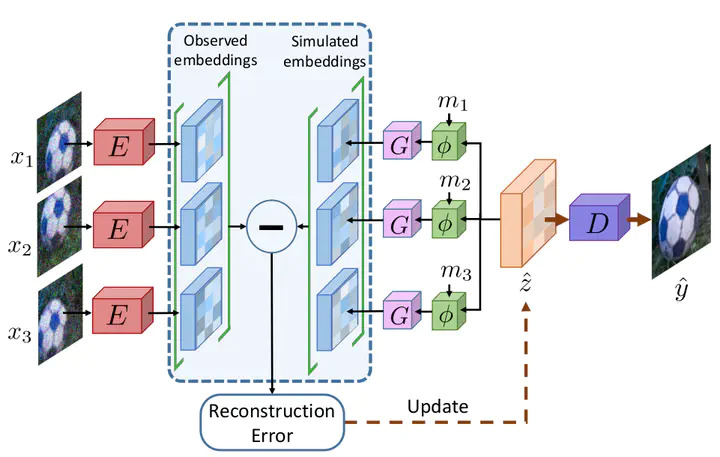
Image enhancement and restoration aim to improve or restore content in an image. Recently, smartphones have become the primary source of photo capture due to their portability. However, their strict size constraints enforce small sensor sizes and compact lenses, which inevitably leads to higher sensor noise. This is countered by increasingly powerful algorithms, aiming to generate more pleasing images by removing noise and blur, by increasing their resolution, by restoring parts damaged by scratches, etc.
This research direction aims at pushing the boundaries of photography through deep learning based image enhancement and restoration. Dedicated deep learning architectures are required to e.g. effectively fuse information from multiple input images. Effective learning formulations are essential in order to train networks with limited available data. In order to achieve photorealistic results, we also explore generative approaches, based on diffusion or other models.
Data compression using a beautiful mathematical concept

The digital storage and transmission of text files, audio clips, or pictures require that they first be described using zeros and ones. This description should be as succinct as possible in order to reduce the storage requirements and the transmission time. That is what data compression is all about. How well a source can be compressed is determined by its Shannon Entropy Rate. For Shakespeare’s English this quantity can be estimated using recurrence times, i.e., by seeing how long it takes for a “monkey on a typewriter” to produce a Shakespeare sonnet. But a finer analysis of data compression requires more than the Shannon Entropy: it calls for the source’s Rényi Entropy Rate. How to estimate it is what this project is all about. More information
Error-free communication, umbrellas, and feedback
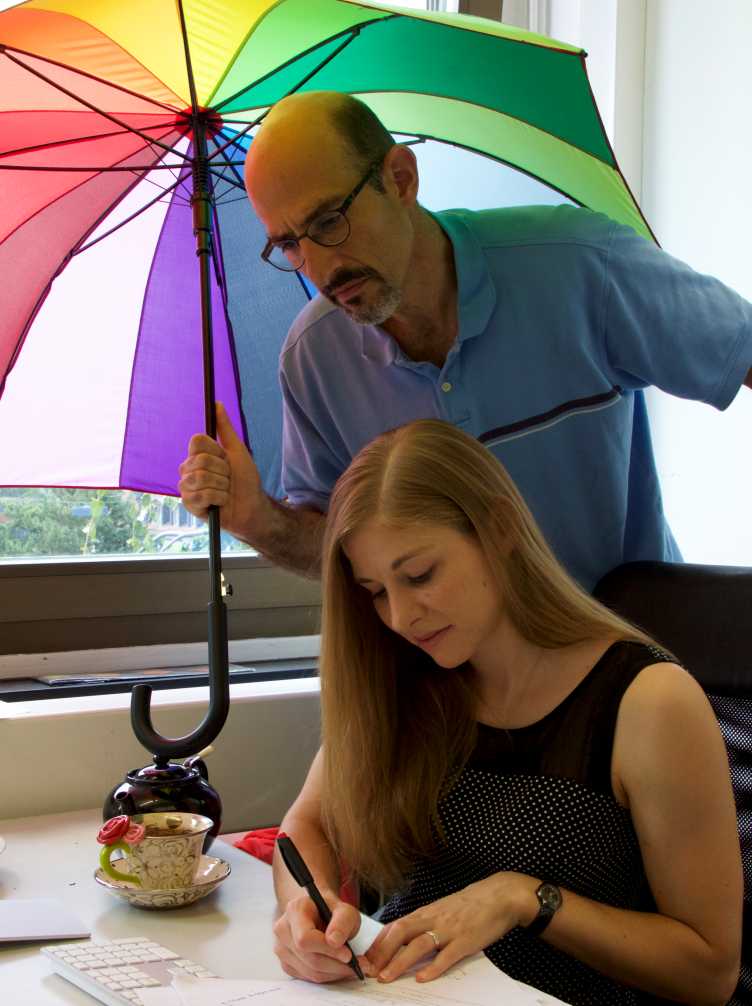
Consider an umbrella whose handle and five ribs have unit length. Open the umbrella to the point where the maximum angle between the ribs is pi/2. Let u1, u2, u3, u4, u5 be the ribs and c be the handle, as vectors oriented away from their common point. Then u1,..., u5 is an orthonormal representation of C5. This is how Lovász’s award-winning 1979 paper begins the derivation of the zero-error capacity – the highest rate at which one can communicate over a channel if no errors are allowed – of the pentagon channel. Computing this capacity for general channels is one of the longest standing problems in Information Theory, and Lovász got his award for solving one of the “simplest” cases. More information
Imaging the force of cancer
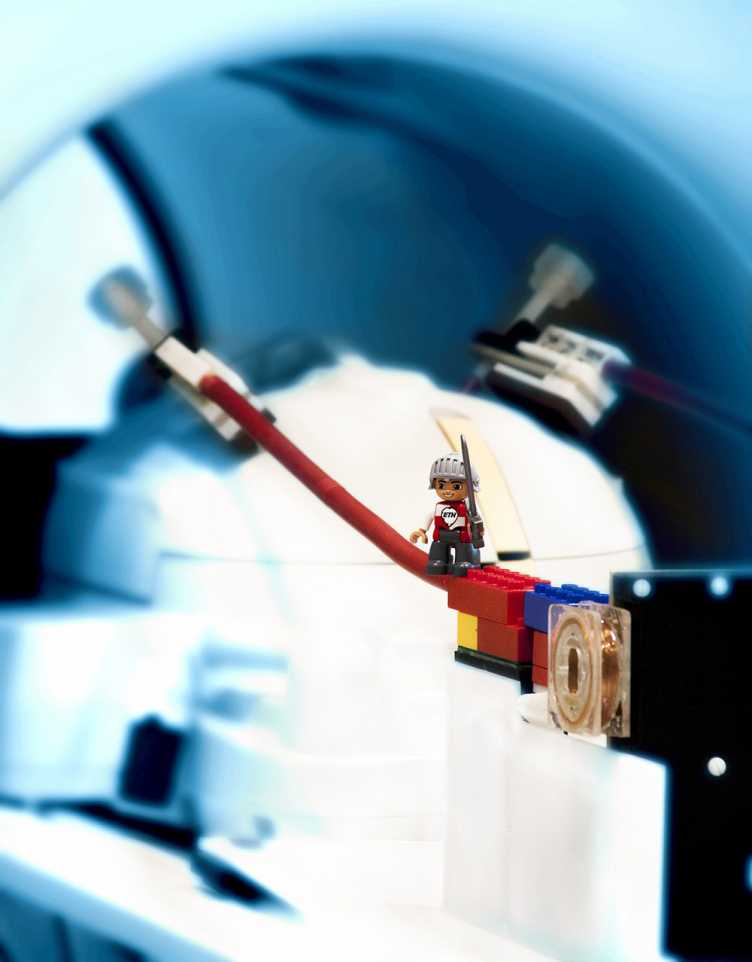
The picture portrays a Duplo soldier raising his sword ready to fight, while standing on top of our magnetic resonance elastography (MRE) setup. In the background, the MRI bore and a head coil can be seen, which is protruded by mechanical actuators used to induce shear waves in the human brain. The wave’s force causes a tiny deformation of the brain tissue, which is measured using MRI, and ultimately converted into 3-dimensional stiffness maps. These can then be used to screen for cancer. This research contributes to the world wide challenge of fighting cancer by providing a new indicator for carcinogenic tissue, as well as, a foundation for new cancer treatment techniques. More information
Human motor management
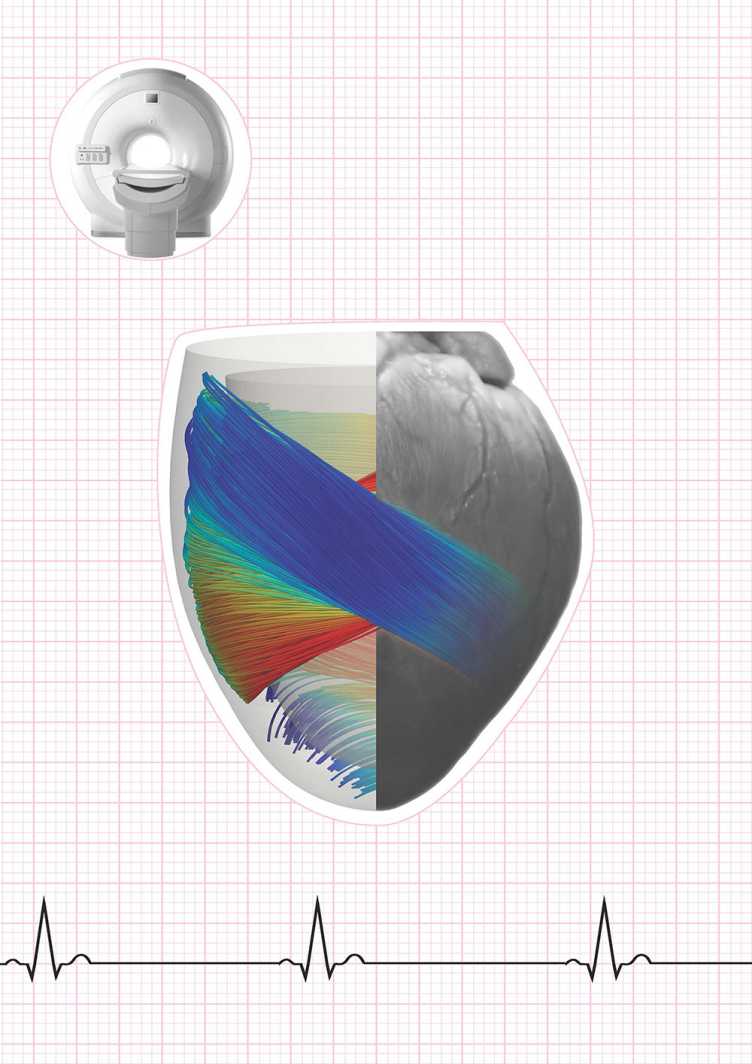
Our heart drives our everyday life. It follows a complex motion pattern to pump blood efficiently through our veins and arteries. It’s made up of helical muscle fibres which have been examined in the past using optical imaging techniques. The old world of optics in medical imaging is represented in the right half of the image. New imaging techniques like Magnetic Resonance (MR) diffusion imaging can depict cardiac fibres from the outside of the human body while the subject is lying in an MR "scanner" as shown in the top left. Dedicated image reconstruction methods allow then to reconstruct the pathways of cardiac muscle fibres across the organ as colorfully depicted in the left picture. MR diffusion imaging allows to improve the current understanding of the living heart, e.g. how it is build up an how this relates to its function. More information
Artificial little brain in a smiley-like pattern
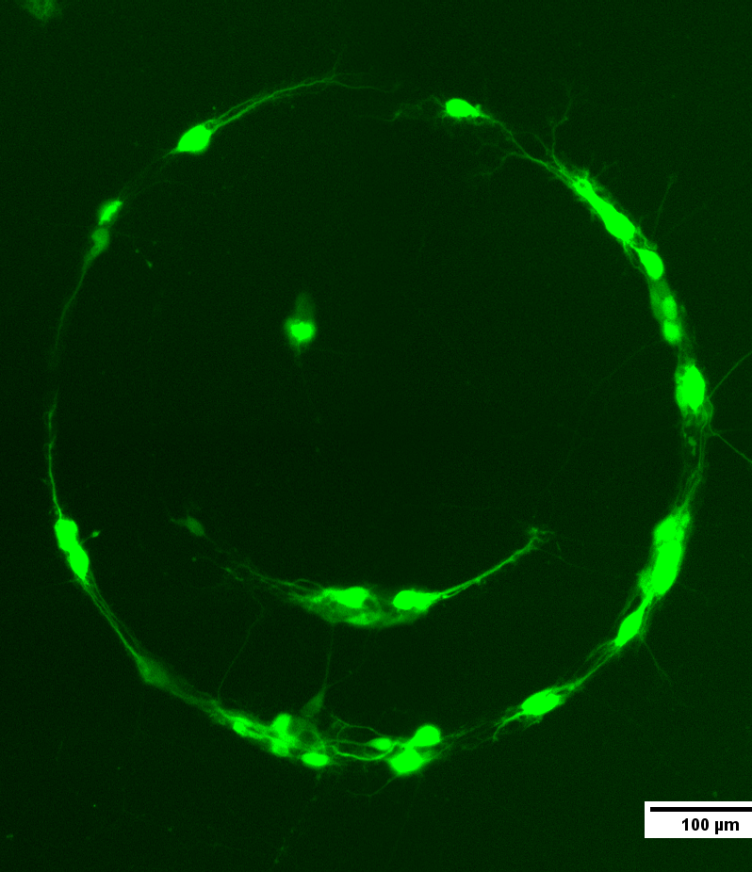
The image represents a network of primary hippocampal embryonic rat neurons arranged in a smiley-like orientation by combination of two methods. The concept of "patterning of neurons with arbitrary defined topology" was initiated at LBB to better understand the basic mechanisms of neurology such as neuron development, signal transmission and neurocomputation. By this deterministic approach, we hope to better control and correlate the response of a neuron to an external signal. Since present approaches all consist of statistical measurements, our approach could lead to important discoveries. More information
Cortical neural network within a 3D paper matrix
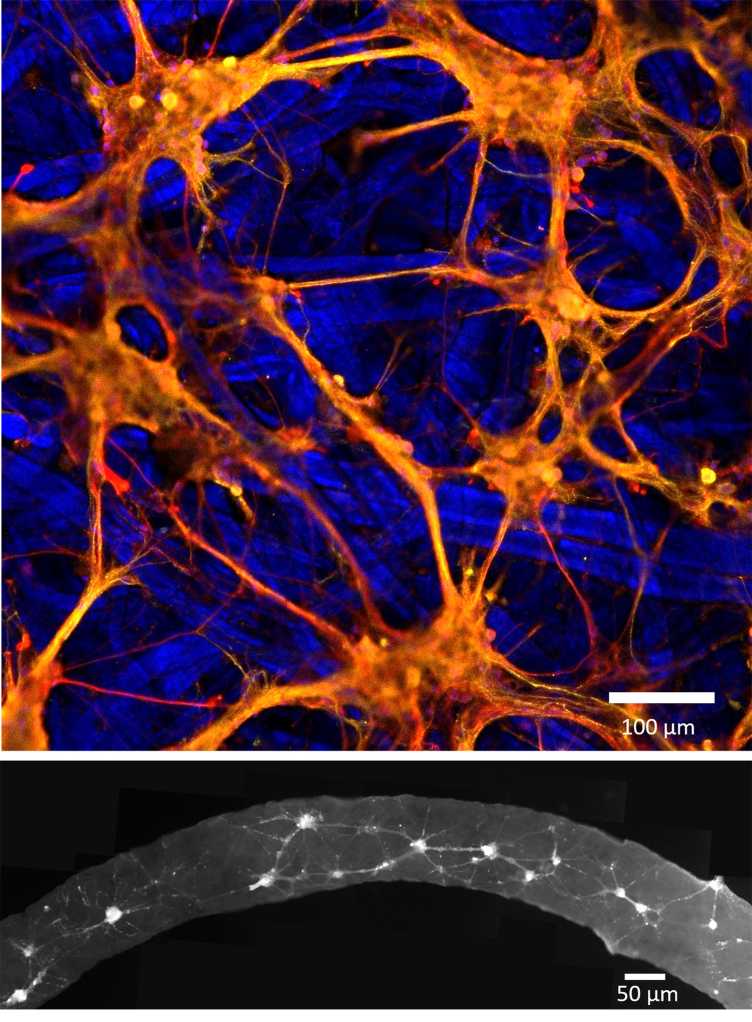
Our aim is to scale down complex neural circuits to well-defined networks in vitro, where we can control exact electrical inputs and monitor the output, while minimizing the countless confounding factors present in vivo. Here, cortical neurons have formed a 3D network within a cellulose paper matrix [top image]. The dendrites (yellow) are the receiving structure of a neuron, while the axons (red) relay the output to the next neurons within the network. By integrating a neural network with a multielectrode array (MEA), we are able to probe exact neural nodes with an electrical stimulus and then monitor and measure the electrical output that signifies neural activity. Using paper as a substrate allows us to build structured 3D networks that can easily be transferred to a MEA for high throughput analysis at multiple time points. More information
Teaching a robot how to hunt
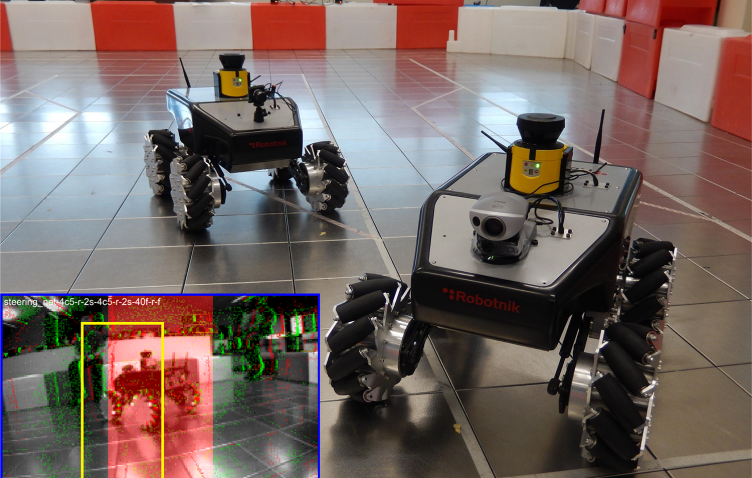
The project result portrayed in the image, is a perfect example of what is "Neuro-morphic Engineering": understanding the underlying principles of the brain and implementing them into hardware in order to achieve fast and intelligent computations. Two 40 kg, omnidirectional and fast predator and prey robots are shown in an arena. The visual of what the predator robot sees through our special silicon retina sensor is also shown. This sensor mimics the processing of the human retina by reporting, at high speeds, only changes in luminosity and, therefore, movement. This drives an artificial neural network on the onboard PC which extracts important features of the scene and understands where the other prey robot is. By giving steering directions to the predator, the network allows to track and follow at 3 m/s its prey. external page More information
Fingerprints of disease in brain waves
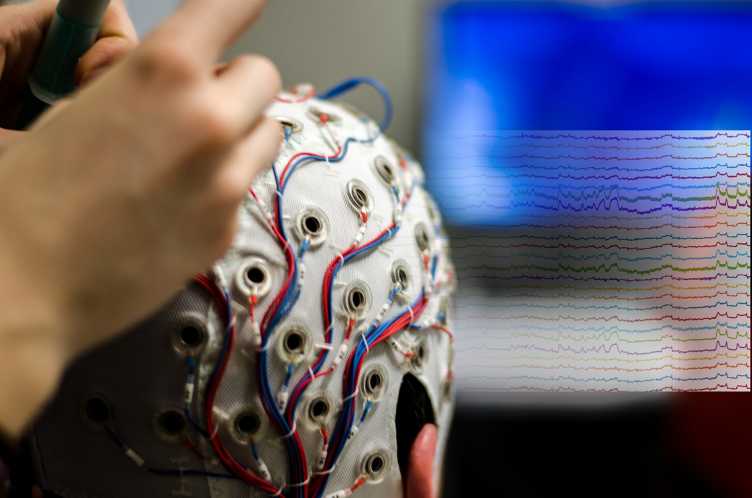
The project concerns non-invasive techniques such as electro- encephalography (EEG) to understand psychiatric disorders. The image shows the preparation of an experiment where a scientist was currently checking on the impedances of the electrodes that need to be kept low to ensure optimal signal to noise ratio. On the right side of the image is an example of the brain signals that have been recorded during an experimental task in which the participant was instructed to focus on a centered box while being exposed to alternating tones. The main question here is: How can we make inference on the perception of the world by these recorded brain signals? The focus of our research is, on the one hand, to find methods or models that try to give an explanation on how diseases affect our cognition, and on the other hand, to find suitable therapies that aim to reverse the disease. More information
A heart for science

The image depicts the setup for an electroencephalography experiment in which we measure how the brain represents information about our heart. The picture shows two scientists inside the EEG cabin, who work on the EEG cap. The syringes contain a salty liquid to improve the impedances of the electrodes on the EEG cap to measure brain activity. The other two scientists outside the cabin test the quality of the heart signal (ECG). During the experiment participants will see a beating heart which is adjusted to their true heartbeat. At some point during the experiment the computer heart will stop matching the true heartbeat. We measure when and how in the brain this mismatch between exteroceptive (visual and auditory) information and interoceptive (internal signals of the heartbeat) is computed. Using mathematical models we can then measure how much each individual uses the information that comes from the body and how noisy that information is. More information
Using high speed MRI to visualize sugar consumption of the heart
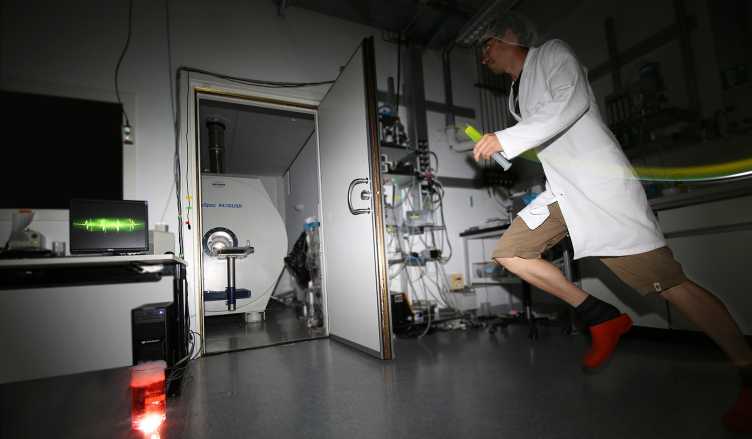
Cardiovascular diseases are the number one cause of death worldwide. We are working on the next generation of non-invasive, MRI based tools to improve diagnosis and therapy guidance of the heart. More precisely, we develop hyperpolarized MRI contrast agents to visualize how the heart uses energy in real-time. Using cutting-edge technology, we can "magnetize" important metabolic molecules. By this the MR sensitivity increases by more than 35’000-fold, enabling the observation of smallest amounts of substance. However, this sensitivity increase is short-lived and in order to minimize the time before injection, our fittest PhD Student sprints with the hyperpolarized contrast agent (yellow syringe) to the MRI scanner (background), where it is injected into an animal (and in the future into human patients). More information
Analog sound, digital brain

Analog subtractive sound synthesis has been widely used in music production since the 1960s. While analog music synthesizers are generally considered superior in terms of sound quality compared to their digital counterparts, analog circuitry suffers from temperature instabilities, component variations, and inflexibility. Digital sound synthesis avoids all of these drawbacks, but the produced audio is affected by aliasing artifacts (think of annoying wheepy zirrp noises). The Integrated Information Processing (IIP) Group has developed a hybrid digital-analog music synthesizer prototype, which combines the best of both worlds: a field-programmable gate array (FPGA) generates 100% aliasing-free waveforms using a novel digital sound synthesis approach, while filtering and amplification is done with analog circuitry. Based on this prototype, a range of open-source instruments for professional music production will be designed. More information
Open-source computing: Chips and Chiplets
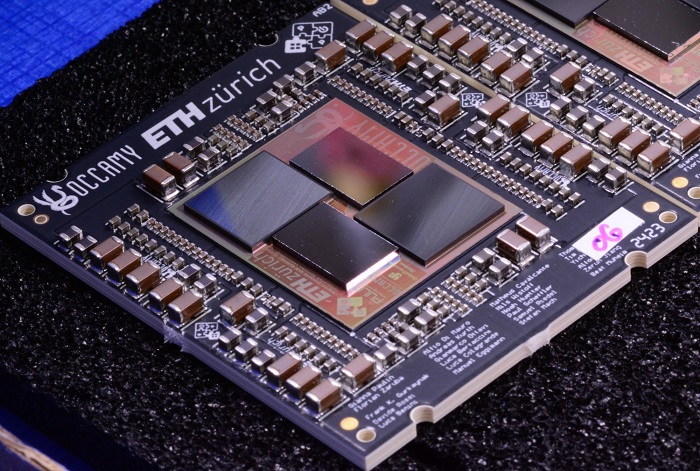
Occamy is a research prototype designed by the Digital Circuits and Systems Group, led by Prof. Luca Benini, to demonstrate and explore the scalability, performance, and efficiency of our RISC-V-based architecture in a 2.5D integrated chiplet system showcasing GlobalFoundries' (GF) technologies and its IP ecosystem, as well as Rambus' and Micron's IP ecosystem. The research prototype, fabricated in GF's 12nm FinFET technology is designed to allow us evaluate and explore the scaling capabilities for AI and HPC workloads of our many-core RISC-V cluster architectures across chiplets, coupled with state-of-the-art memory controllers for ultra-high bandwidth off-chip data access. The carrier PCB mounts the Hedwig interposer, fabricated in 65nm technology, and a set of decoupling capacitors. Overall, the Occamy system includes 432+2 RISC-V cores achieving a peak system performance of 768 GFlop/s in double precision and 6.144 TFlop/s in 8-bit floating-point formats. Occamy is one of the 50+ chips fabricated within our flagship project, the "Parallel Ultra Low-Power - PULP" platform (external page https://pulp-platform.org/), completely based on open-source hardware, freely accessible to academia and industry. More information
The next generation cellular network (5G) promises to deliver 1,000 times more data traffic than current networks. Such progress is needed to meet the ever-growing demand of bandwidth on mobile devices, e.g. tablets and smartphones. Radically novel approaches are needed to support multi-Gbit/s and even Tbit/s data rates needed for next generation networks. An overview of current projects in this area:
Steering towards 5G
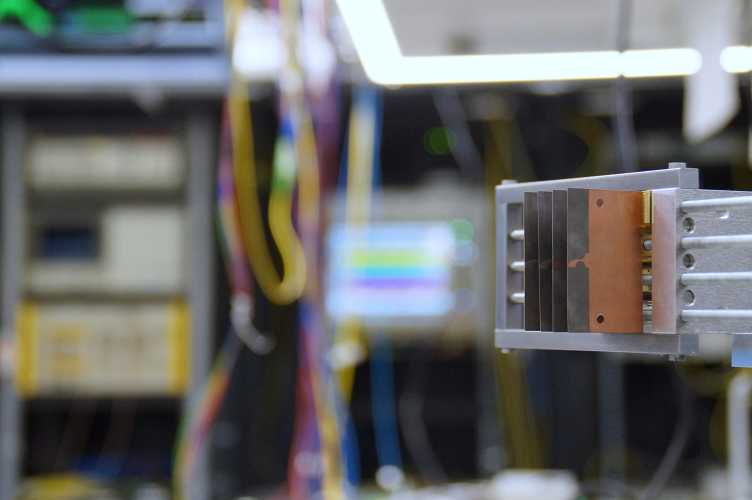
The picture shows a 60 GHz phased antenna array in our laboratory. The signals from the four antennas interfere and create a strong beam in the desired direction i.e. towards the user. The direction of the beam can be steered by delaying the signals to the antennas with respect to each other. We design and realize circuits that are capable of changing the beam direction within one thousandth of a billionth of a second. We believe, that in future mobile networks this extremely fast switching between users will enable almost simultaneous usage of resources for all users. Ultimately, this will tremendously increase the user data rates. More information
Radios and light: wireless systems for the future
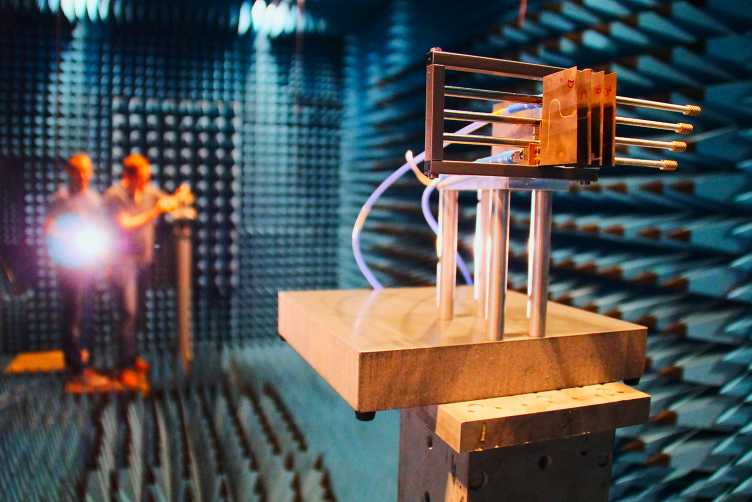
Testing of an ultra-wideband antenna array in the D-ITET anechoic chamber. The array of antennas in the foreground is designed to have ultra-broad bandwidth and the capability to change direction with ultra-fast speeds without any physical movement, but only via electrical control. In our project, we work on novel radio techniques using optical technology. In this way, we can dramatically enhance the performance of wireless systems and antennas. "Light-circuits" can be much faster and more broadband than traditional electrical circuits. This novel approach can enable ultrafast speeds and the very large bandwidths to wireless communications systems needed in the near future. More information
The colors of speed: ultrafast modulators
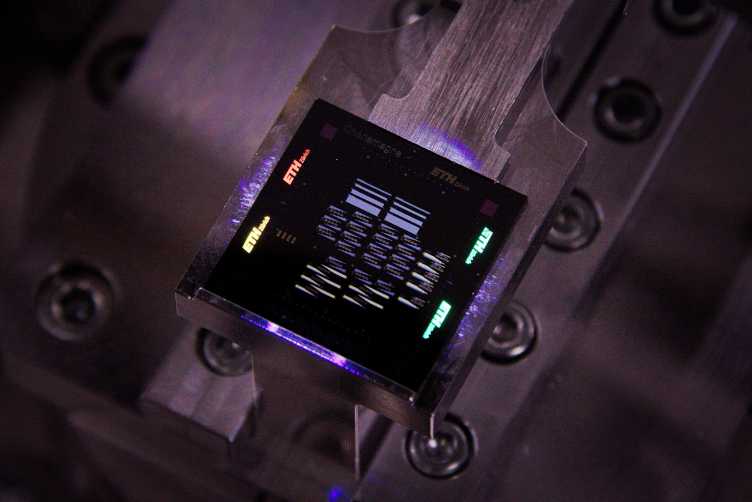
Photonic integrated circuit mounted on the test setup in our lab. The chip contains a novel type of modulators, called plasmonics organic hybrid modulators, that can encode information using light at ultrafast speeds (>110 GHz bandwidth), with ultra-compact footprints (10s µm2) and ultra-low power consumption (only 10s fJ/bit). In our project, we work on novel control networks using optical technology. In this way, we can dramatically enhance the performance of wireless systems and antennas by using optical technology. "Light-circuits" as the one in the picture can be much faster and broadband than traditional electrical circuits. In this way, we can enable ultrafast speeds and the very large bandwidths to wireless communications systems needed in the near future. More information
The wires for light
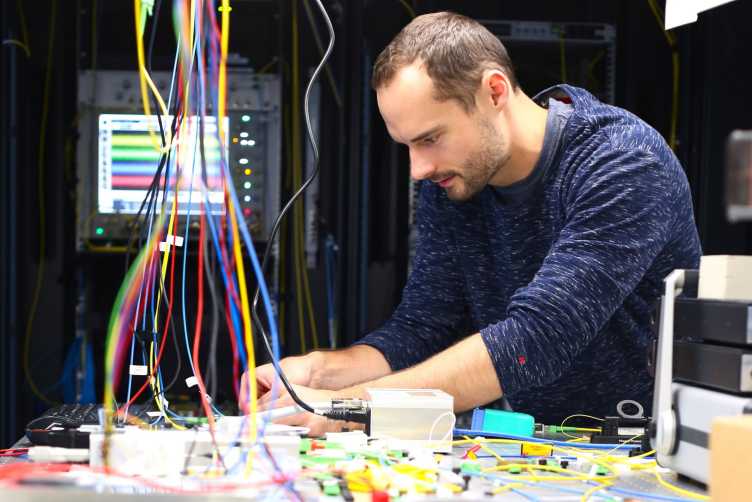
Felix Abrecht assembling a test setup in the Systems Laboratory of the IEF group, for an experiment on high-capacity wireless communication networks. In our project, we work on novel radio techniques using optical technology. In this way, we can dramatically enhance the performance of wireless systems and antennas. “Light-circuits” can be much faster and more broadband than traditional electrical circuits. This novel approach can enable ultrafast speeds and the very large bandwidths to wireless communications systems needed in the near future. More information
Optical communication – the future of high speed information transmission
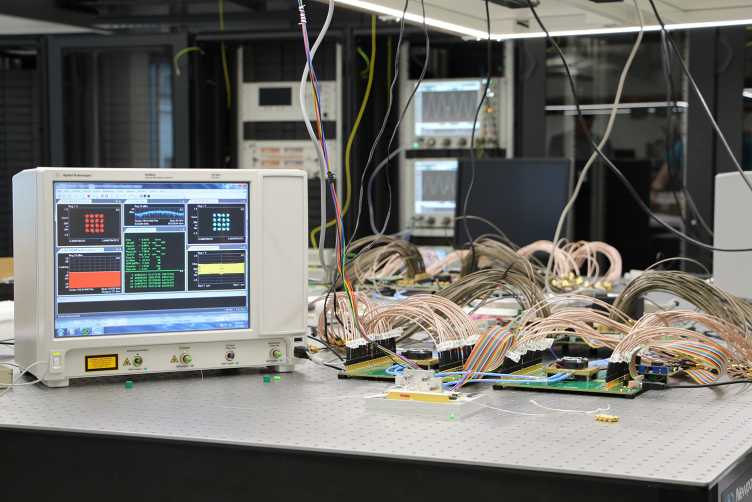
A real-time optical coherent transmitter is shown. Data is generated in a computer chip. It is linked with the brownish electrical cables to two high speed analog-to-digital converters. This signal is used to modulate a laser light with highest speed. The blue cables are connecting the converters with an optical modulator (golden cuboid in the front). The oscilloscope on the left shows the performance analysis of the transmitter. Laser light is guided through the thin optical fibers (leaving and entering the green plugs at the bottom of the oscilloscope). This setup shows how the next step of high speed communication could be realized. Optical fibers are able to transmit much more information than an electrical cable (e.g. the USB connection everyone uses). More information
Levitodynamics

We use a levitated nanoparticle in ultrahigh vacuum for ultrasensitive force measurements. The nanoparticle’s displacement due to external forces can be measured with quantum-limited sensitivity. On resonance, the force sensitivity reaches 2 zepto Newtons per root Hertz, equivalent to the gravitational force between two humans separated by 10'000 km or the electrostatic force between two electrons separated by 0.2 millimeters.
2D Optoelectronics
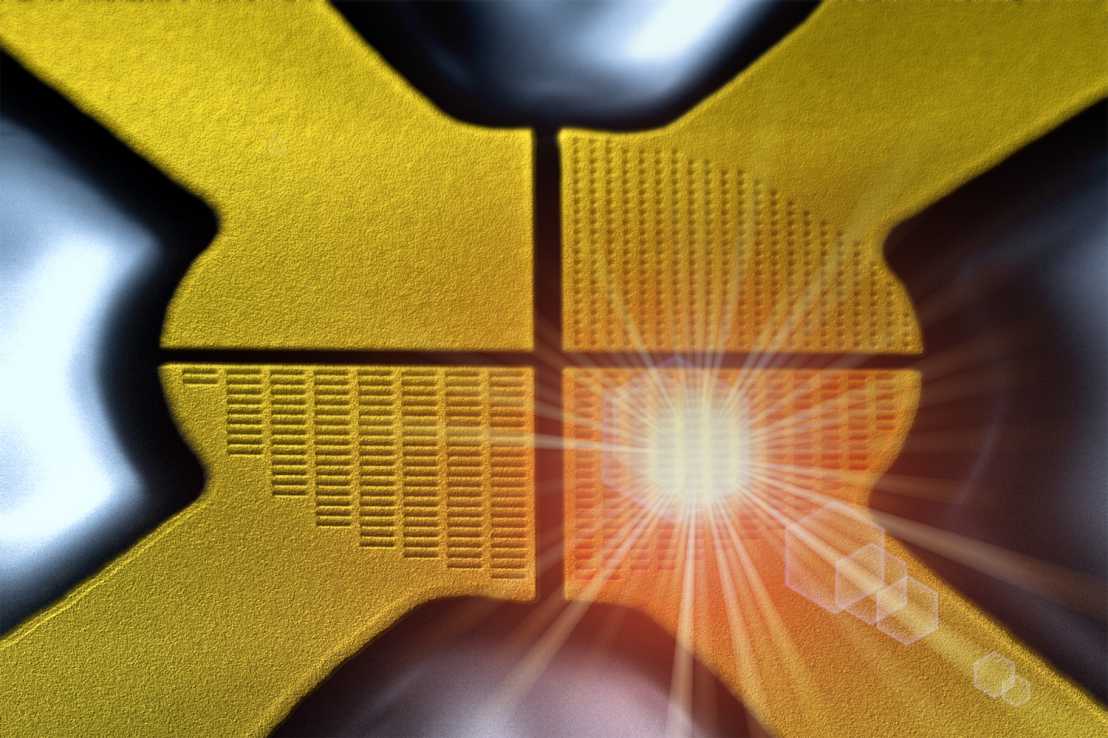
We develop optoelectronic devices, such as photodetectors or light emitting diodes, using 2D materials as building blocks. These materials grow in two dimensions and are only a few atoms thick. Examples are graphene, hexagonal boron nitride and transition metal dichalcogenides. 2D materials can be stacked on top of each other to generate heterostructures, so-called van der Waals materials. This material platform allows us to miniaturize the footprint of optoelectronic devices, thereby enabling the co-integration of optical and electronic circuitry.
Gases that capture electrons
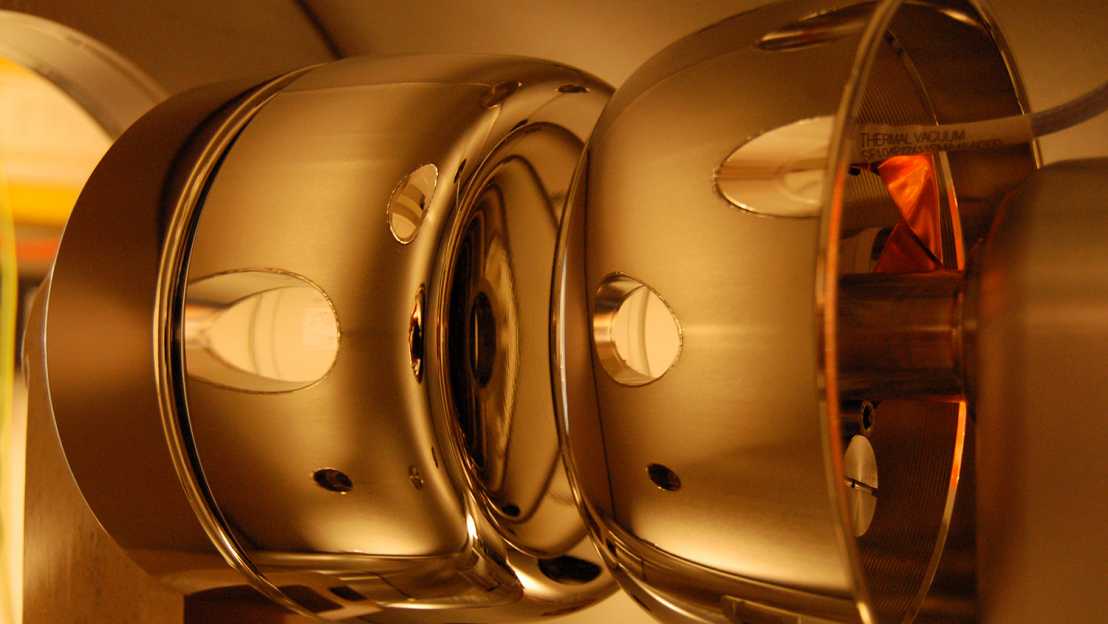
Photography of the inside of a gas vessel, featuring two nickel-plated electrodes. The openings of the vessel are reflected onto the electrodes, giving the illusion that the latter have holes in them. The reason why the electrodes are so smooth and rounded is to create a perfectly homogenous electric field in their center. In this experiment, a UV laser pulse releases up to 10 million electrons from the left electrode. The electric field accelerates the electrons through the gas towards the right electrode. The fastest electrons may ionize gas molecules and free new electrons, which in turn ionize other molecules. An electrical discharge has been initiated. However, some molecules have the ability to capture electrons, thus chocking off electrical discharges. This ability is exactly what is needed for a gas to be a good electrical insulator such as the widely-used sulfur hexafluoride (SF6), which is one of the strongest known greenhouse gases. Our research project aims to identify new gases with low global warming potential that could replace SF6 in the electrical equipment necessary for the energy transmission and distribution systems. More information
High voltage water drops
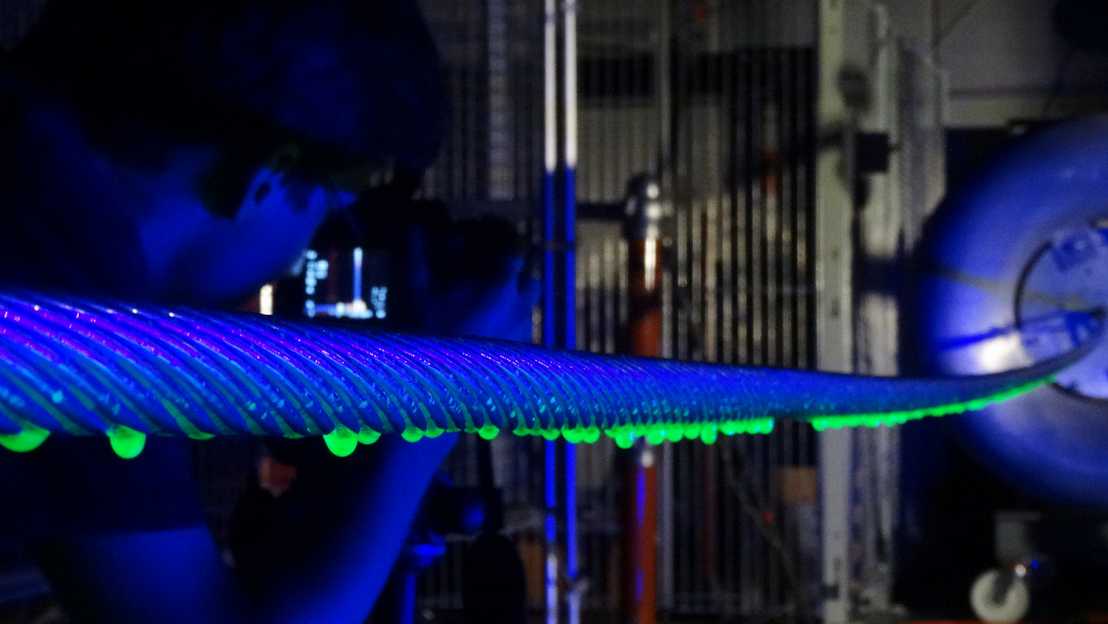
Our team is investigating the environmental effects of a novel power transmission technology: hybrid AC/DC transmission. The main idea is to convert existing AC transmission corridors (this is the state of the art power transmission technology in Europe today) to systems in which AC and DC lines are used on the same tower. This can significantly increase the power throughput of an existing corridor and can delay or prevent the construction of new overhead lines. This concept will be implemented in Germany in the coming years in a project called “Ultranet” – the first of its kind worldwide. Our team is supporting this project by investigating fundamental effects in the areas of electromagnetic fields and noise emissions. Water on the lines plays a crucial role with regard to these effects. We therefore analyze the distribution and shape of water drops by adding a UV sensitive substance to the water. More information
Ultra-High Bandwidth Power Amplifiers
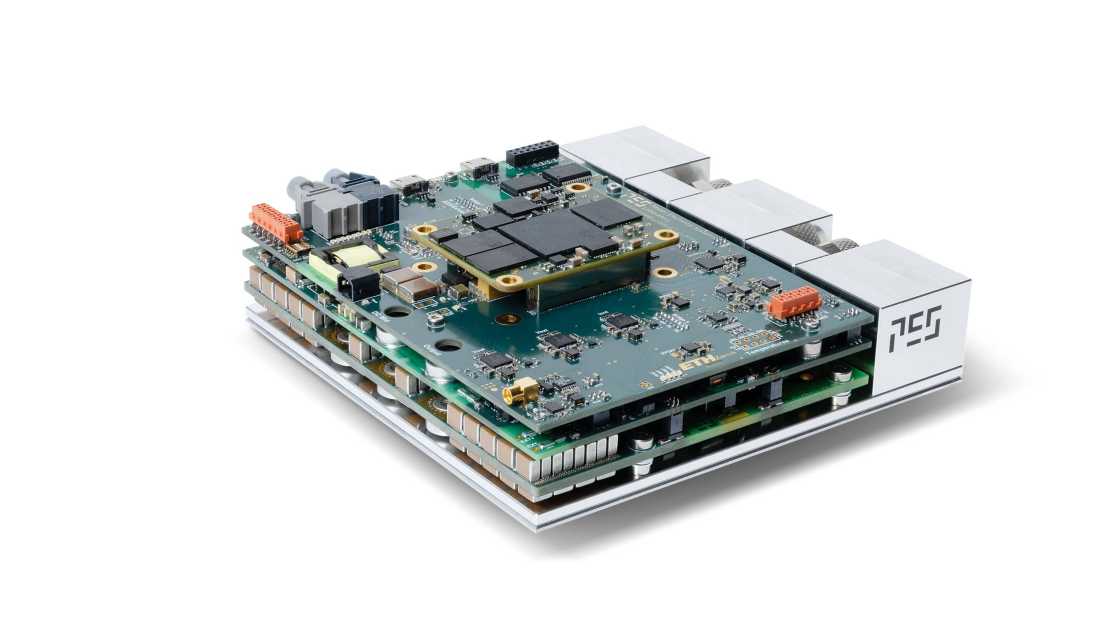
Ultra-High Bandwidth Power Amplifiers (PAs) are essential to, e.g., analyze renewable energy systems for grid code compliance or to emulate the electric motor behavior and battery characteristics of electric vehicles in the course of advanced drive systems testing. State-of-the-art linear PAs typically achieve a bandwidth of several tens of kHz but are highly inefficient resulting in large cooling effort and do not allow bidirectional power flow. Switch-mode PAs offer considerably higher efficiencies but at bandwidths limited to typ. 5 kHz.
This research project is aiming at a massive improvement (factor of 10) of the output dynamics and/or bandwidth of switch-mode PAs. This is achieved with the adoption of latest wide-bandgap semiconductor technology, an advanced power circuit topology featuring a very high effective switching frequency of 4.8 MHz and new DC-capable current sensing concepts with very high bandwidth (>30 MHz).
The realized prototype system achieves a full-power / full-scale output voltage bandwidth of 100 kHz at 10 kW output power, an efficiency of 96% and a power density of 25 kW/dm3. It outperforms state-of-the-art systems in all performance characteristics and forms the basis for the next generation industrial test systems.
Compact Linear-Rotary Actuator Drive System for Future Implantable Pulsatile Total Artificial Hearts
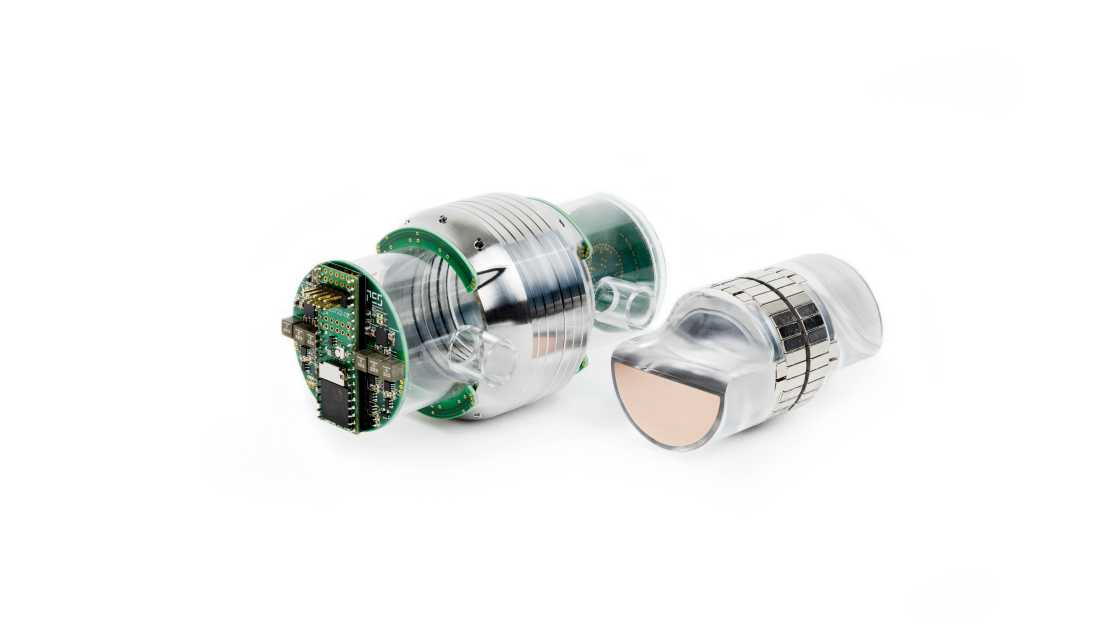
Concurrently to the ageing society in industrial nations, the number of people suffering from severe heart failures has increased over the last decades. At the end stage, a heart transplantation is often the only effective treatment. However, the number of suitable donor hearts is limited. Total artificial hearts are a promising solution to replace a failing heart, but the currently available artificial heart concepts still suffer from limited durability and relatively high complications rates, which can also be related to their complex design and limited hemocompatibility due to high velocities within the pumps.
In this project a radically new low-complexity pumping concept is proposed, which offers a pulsatile physiological flow with only one moving part. This requires a specially designed impeller/mover that follows a combined linear-rotary trajectory. Such concept is for the first time implemented as a demonstrator system in the course of this research project. The conceptualization and realization of the system was possible by bringing together experts of very diverse domains (actuators, power electronics, fluid dynamics, medicine, surgery, etc.) in the context of a collaboration between the Medical University of Vienna, ETH Zurich and Charité - Universitätsmedizin Berlin.
Assuming a successfully completed test phase, the new device will represent a major step towards improved total artificial heart systems and/or improved long-term prognosis of end-stage heart failure patients.